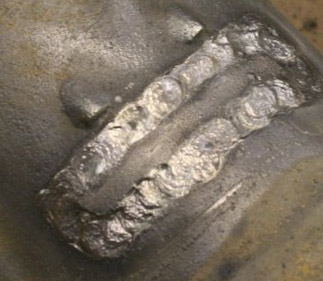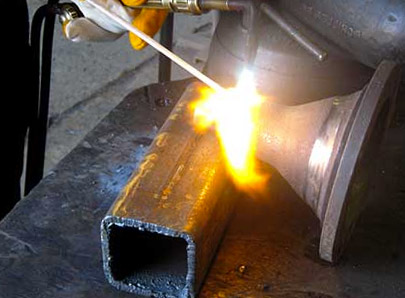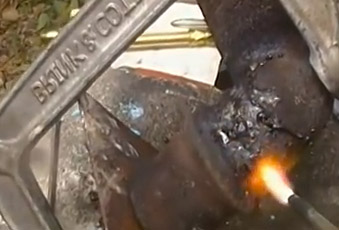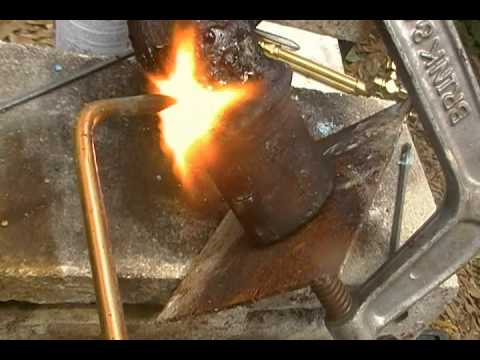Summary
Cast iron (gray, white and malleable) is a man-made alloy made from iron, carbon, and silicon. A portion of the carbon exists as free carbon or graphite.
Total carbon content is between 1.7 and 4.5 percent.
Cast iron is used for water pipes, machine tool castings, transmission housing, engine blocks, pistons, stove castings, etc.
The metal can be brazed or bronze welded, gas and arc welded, hardened, or machined.
In terms of limitations, the cast iron must be preheated prior to welding. It cannot be worked cold.
Often brazing is the best approach for repairing cast iron, particularly when the parts need to be rebuilt and then machined to the right tolerance.
Overview
If you want to braze cast iron, melting the base metal is not necessary since the rod has a built-in flux.
Clearance should be around .003 for maximum tensile and shear strength.
The rod takes extreme heat, above 1400 degrees to penetrate the pores of the metal.
The rod required to braze cast iron welds all cast iron, brass, nickel, copper, and more than 50 different kinds of steel, including stainless.
Open the pours around the area to be repaired, drill, and grind out a U shape in the metal, so it is no longer a hairline crack.
With an angle grinder, practice with cast iron by grinding a slot 1/16th to 1/8th of an inch into the metal. Use a brazing or cutting tip to bring the metal to 1400 degrees.
The metal will start to turn red at 600 degrees, but continue heating.
Test the rod on the metal 1/4 inch outside the bulk of the flame.
The rod has a flux core that will melt much lower than the rod, so if the rod itself will not melt, have patience.
When you are close to 1400 degrees, it will look like you’re going to burn a hole in the metal but do not worry.
Once you see the rod itself is melting, scratch the rod all around the area to be repaired.
The rod will melt and, with the help of the flux core, will fuse down into the metal.
When you pull the torch, it will be cherry red for about 20 seconds.
If you have followed the instructions explicitly and scratched the rod all around the area to be repaired thoroughly, you will have the strongest weld possible on that particular metal.
You may then grind, shape, polish and paint as desired.

Related Read: How To Weld Cast Iron
Cast Iron Properties
Cast iron has:
- Brinell hardness number of 150 to 220 (no alloys) and 300 to 600 (alloyed)
- Tensile strength of 25,000 to 50,000 psi (172,375 to 344,750 kPa) (no alloys) and 50,000 to 100,000 psi (344,750 to 689,500 kPa) (alloyed)
- Specific gravity of 7.6
- High compressive strength that is four times its tensile strength
- High rigidity
- Good wear resistance
- Fair corrosion resistance

Gray Cast Iron
If the molten pig iron is permitted to cool slowly, the chemical compound of iron and carbon breaks up to a certain extent. Much of the carbon separates as tiny flakes of graphite scattered throughout the metal. This graphite-like carbon, as distinguished from combined carbon, causes the gray appearance of the fracture, which characterizes ordinary gray cast iron.
Since graphite is an excellent lubricant, and the metal is shot throughout with tiny, flaky cleavages, gray cast iron is easy to machine but cannot withstand a heavy shock. Gray cast iron consists of 90 to 94 percent metallic iron with a mixture of carbon, manganese, phosphorus, sulfur, and silicon. Special high-strength grades of this metal also contain 0.75 to 1.50 percent nickel and 0.25 to 0.50 percent chromium or 0.25 to 1.25 percent molybdenum.
Commercial gray iron has 2.50 to 4.50 percent carbon. About 1 percent of the carbon is combined with the iron, while about 2.75 percent remains in the free or graphitic state. In making gray cast iron, the silicon content is usually increased, since this allows the formation of graphitic carbon. The combined carbon (iron carbide), which is a small percentage of the total carbon present in cast iron, is known as cementite.
In general, the more free carbon (graphitic carbon) present in cast iron, the lower the combined carbon content and the softer the iron.
Tests for Gray Cast Iron
Appearance Test
The un-machined surface of gray cast iron castings is a very dull gray in color and maybe somewhat roughened by the sand mold used in casting the part. Cast iron castings are rarely machined all over. Un-machined castings may be ground in places to remove rough edges.
Fracture Test
Nick a corner all around with a chisel or hacksaw and strike the corner with a sharp blow of the hammer. The dark gray color of the broken surface is caused by fine black specks of carbon present in the form of graphite. Cast iron breaks short when fractured. Small, brittle chips made with a chisel break off as soon as they are formed.
Spark Test
A small volume of dull-red sparks that follow a straight line close to the wheel are given off when this metal is spark tested. These break up into many fine, repeated spurts that change to a straw color.
Torch Test
The torch test results in a puddle of molten metal that is quiet and has a jelly-like consistency. When the torch flame is raised, the depression in the surface of the molts-puddle disappears instantly. A heavy, tough film forms on the surface as it melts. The molten puddle takes time to harden and gives off no sparks.

White Cast Iron
When gray cast iron is heated to the molten state, the carbon completely dissolves in the iron, probably combining chemically with it. If this molten metal is cooled quickly, the two elements remain in the combined state, and white cast iron is formed. The carbon in this type of iron measures above 2.5 to 4.5 percent by weight, and is referred to as combined carbon. White cast iron is very hard and brittle, often impossible to machine, and has a silvery white fracture.
Malleable Cast Iron
Malleable cast iron is made by heating white cast iron from 1400 to 1700°F (760 and 927°C) for abut 150 hours in boxes containing hematite ore or iron scale. This heating causes a part of the combined carbon to change into the free or uncombined state. This free carbon separates in a different way from carbon in gray cast iron and is called temper carbon. It exists in the form of small, rounded particles of carbon which give malleable iron castings the ability to bend before breaking and to withstand shock better than gray cast iron. The castings have properties more like those of pure iron: high strength, ductility, toughness, and ability to resist shock. Malleable cast iron can be welded and brazed. Any welded part should be annealed after welding.
Appearance Test
The surface of malleable cast iron is very much like gray cast iron, but is generally free from sand. It is dull gray and somewhat lighter in color than gray cast iron.
Fracture Test
When malleable cast iron is fractured, the central portion of the broken surface is dark gray with a bright, steel-like band at the edges. The appearance of the fracture may best be described as a picture frame. When of good quality, malleable cast iron is much tougher than other cast iron and does not break short when nicked.
Spark Test
When malleable cast iron is ground, the outer, bright layer gives off bright sparks like steel. As the interior is reached, the sparks quickly change to a dull-red color near the wheel. These sparks from the interior section are very much like those of cast iron; however, they are somewhat longer and are present in large volume.
Torch Test
Molten malleable cast iron boils under the torch flame. After the flame has been withdrawn, the surface will be full of blowholes. When fractured, the melted parts are very hard and brittle, having the appearance of white cast iron (they have been changed to white or chilled iron by melting and fairly rapid cooling). The outside, bright, steel-like band gives off sparks, but the center does not.
Video of How To Braze a Cast Iron Exhaust Manifold

I am brazing an engine block. The main support mounting for the starter is drilled into a portion of the block, one going solidly into the block, the other goes through a slight triangle section where the bolt pops through the top after it is cinched in. This piece has sheared off. It is a part that is maybe two inches high and it goes right through the middle of the threading hole. My question is once I get the part brazed on, am I going to have to rethread the hole? And any advice as how to prepare the part and the block portion? I will be underneath the vehicle and I wont have much room. I am using the bernzomatic max heat torch and mapp gas, and I have a 1/16th rod that has a orange flux coating. It melts at high heat, much like was advised. Any advice or ideas would be very helpful. Thank you.
I can’t help much (see below) but can empathize. I have a Massey Ferg 6160 front axle support grey cast iron casting with the mounting “ears” fractured off last Monday – 3 bits in all (main casing and 2 ears).. I am – probably – going to have a go at brazing them back in place. I intend to bolt the broken bits in place and make small spot welds to hold the pieces in place relative to each other. Then I will remove and heat up the casting in a barbeque, maybe with the aid of a vacuum cleaner output air stream, and then remove onto firebricks and apply local heat with a Benzomatic mapp gas torch to do the brazing (using a prefluxed rod). Maybe this will work.
As far as threading your bolt hole is concerned, it seems highly likely that you will have to recut the thread but what I would do is put the correct bolt in place and the broken bit (maybe with a dab of superglue to hold them together), then do the spot weld business as above, then heat gently to break superglue and unscrew bolt. This should align the thread. Then braze (you should heat the block up a bit to help remove stress but this may be difficult). The brazing will not damage the thread but will probably obstruct it – if you are lucky, a thread cutter will clear the thread for you. If you are unlucky, but the brazing is good, you will need to reinstate the thread by helicoiling.